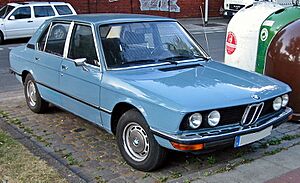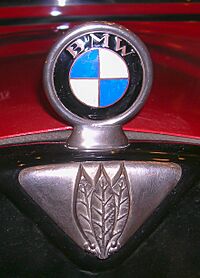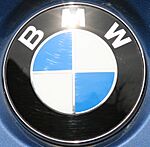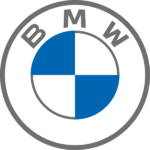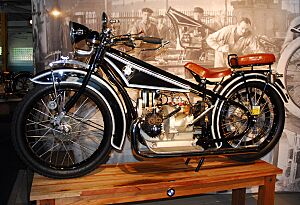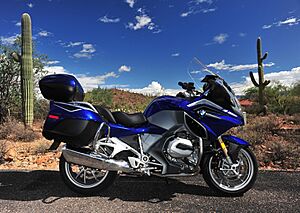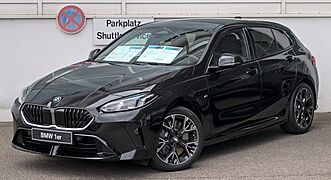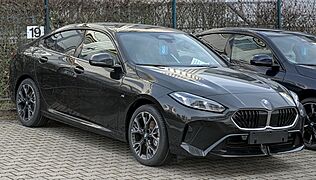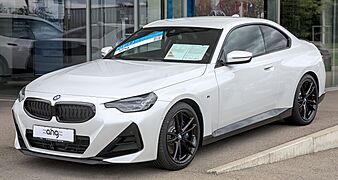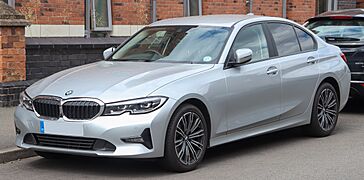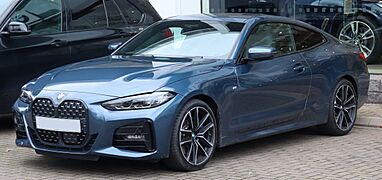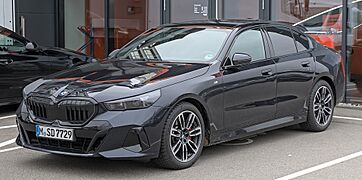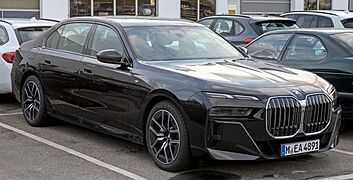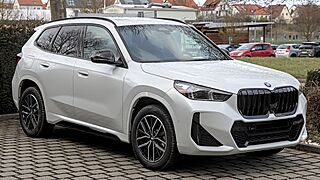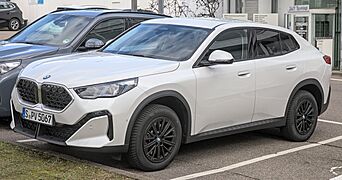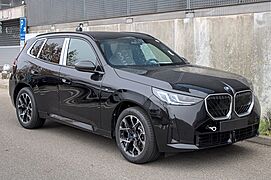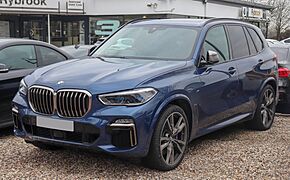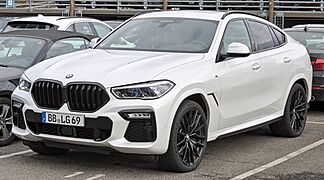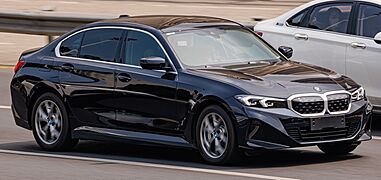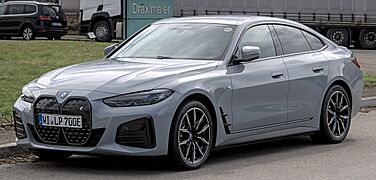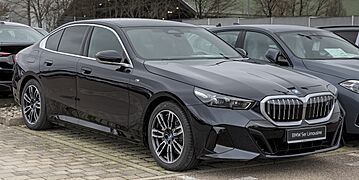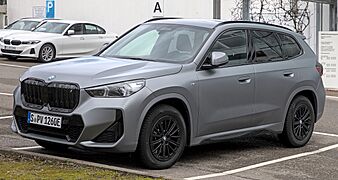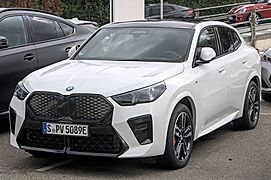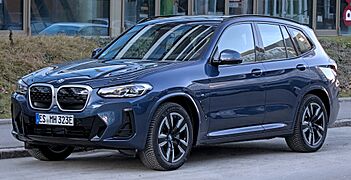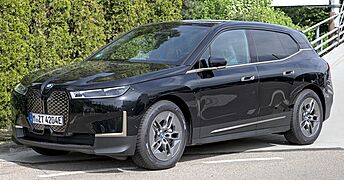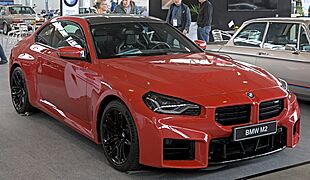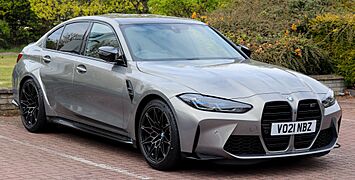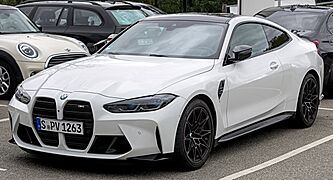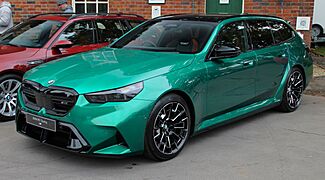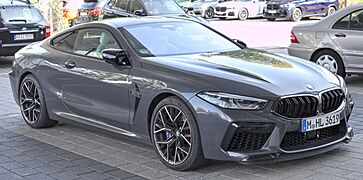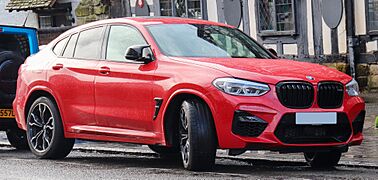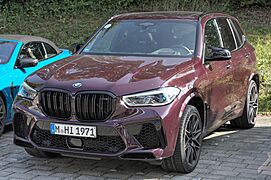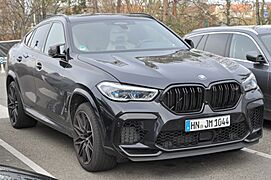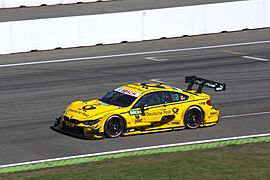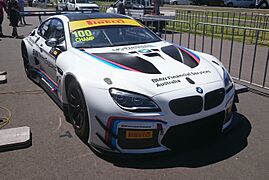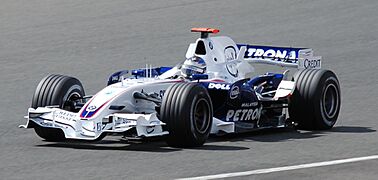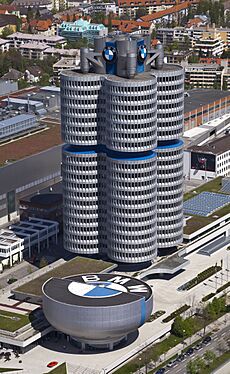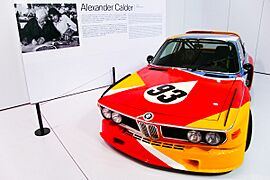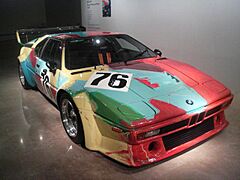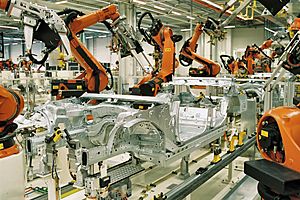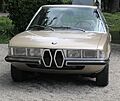BMW facts for kids
 |
|
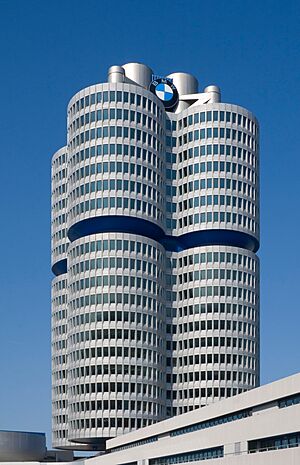
BMW Headquarters in Munich, Germany
|
|
| Public | |
| Traded as | |
| Industry | Automotive |
| Predecessors |
|
| Founded | March 7, 1916 (official date) 1922 (de facto date) |
| Founders | Camillo Castiglioni Franz Josef Popp |
| Headquarters |
,
Germany
|
|
Area served
|
Worldwide |
|
Key people
|
|
| Products | |
| Brands |
|
|
Production output
|
|
| Services | Car-sharing services, financing, leasing, insurance and other financial services |
| Revenue | |
|
Operating income
|
|
| Total assets | |
| Total equity | |
| Owners |
|
|
Number of employees
|
154,950 (2023) |
| Top - 0-9 A B C D E F G H I J K L M N O P Q R S T U V W X Y Z |
BMW (which stands for Bayerische Motoren Werke Aktiengesellschaft) is a famous German company. It makes awesome luxury cars and motorcycles. BMW's main office is in Munich, Germany.
The company sells its cars under the BMW, Mini, and Rolls-Royce names. Its motorcycles are sold under the BMW Motorrad brand. In 2023, BMW was one of the world's largest car makers. It produced over 2.5 million vehicles that year. BMW also has a long and exciting history in motor-sport, especially in racing cars and motorcycles.
BMW has its main office in Munich. It builds vehicles in many countries around the world. These include Germany, the United Kingdom, the United States, Brazil, Mexico, South Africa, India, and China. A family called the Quandt family has been a major owner of BMW for a long time. They helped save the company from serious financial trouble in 1959.
History of BMW
BMW's story began with two companies that made aircraft engines. One was Otto Flugmaschinenfabrik, started in 1910. The other was Rapp Motorenwerke, started in 1913. In 1922, these companies came together and became what we know today as BMW.
BMW's first product was an engine for fighter planes. It was called the BMW IIIa and was designed in 1917. After World War I, BMW started making other things. They made motorcycle engines, farm tools, and even railway brakes. In 1923, BMW made its first motorcycle, the BMW R 32.
BMW started making cars in 1928. They bought a company that built a car called the Dixi. The first car sold as a BMW was the BMW 3/15. In the 1930s, BMW started making sports cars and bigger luxury cars.
During World War II, BMW focused on making aircraft engines. After the war, BMW's factories were badly damaged. They were not allowed to make cars or aircraft for a while. To survive, the company made pots, pans, and bicycles. In 1948, BMW started making motorcycles again. Car production restarted in 1952 with the BMW 501 luxury car.
In 1955, BMW also started making a smaller, cheaper car called the Isetta. But sales of luxury cars were slow, and the small cars didn't make much money. BMW faced serious financial problems. In 1959, a rival company almost bought BMW. Luckily, a big investment from the Quandt family helped BMW survive.
A successful small car, the BMW 700, helped the company recover. This allowed them to create new, sportier sedans.
In 1962, BMW introduced the BMW New Class sedans. These cars helped BMW become known for making sporty cars. Throughout the 1960s, BMW added more types of cars, including coupes and luxury sedans. The BMW 5 Series came out in 1972. Then came the BMW 3 Series in 1975, the BMW 6 Series in 1976, and the BMW 7 Series in 1978.
The BMW M division, which makes high-performance cars, released its first road car in 1978. It was a super sports car called the M1. Later, they made the BMW M5 in 1984 and the BMW M3 in 1986. In 1986, BMW also introduced its first V12 engine in the 750i luxury sedan.
BMW returned to making two-seat sports cars with the BMW Z1 in 1989. The BMW Z3 in 1995 was their first mass-produced two-seat sports car. In 1999, BMW entered the SUV market with the BMW X5.
In 1994, BMW bought the Rover Group, another car company. However, this didn't go well, and BMW lost a lot of money. In 2000, BMW sold most of the Rover brands, keeping only the Mini brand. In 1998, BMW also bought the rights to the Rolls-Royce brand.
BMW started using turbocharged petrol engines in many of its cars in the 2010s. The first hybrid BMW was the 2010 BMW ActiveHybrid 7. BMW's first mass-produced electric car was the BMW i3 city car, released in 2013. In 2014, BMW made its first front-wheel drive car, the BMW 2 Series Active Tourer.
In August 2019, Oliver Zipse became the head of the BMW Group.
BMW in the 21st Century
In 2020, BMW's sales dropped due to the COVID-19 pandemic. However, sales started to recover by the end of that year. This was helped by BMW using new technologies and working with other companies. For example, they partnered with Daimler on self-driving technology. BMW also made smart choices, like building more SUVs in their U.S. factory. This helped them handle trade challenges and changing customer needs.
In January 2022, BMW announced a special edition of the BMW 7 Series called "The Final V12." This was the last BMW car to have a V-12 engine.
BMW Branding
What the Name Means
BMW stands for Bayerische Motoren Werke. This means "Bavarian Motor Works" in English. "Bayerische" refers to Bavaria, a state in Germany where the company started. "Motoren Werke" means "Motor Works" or "Engine Factory." The "AG" at the end of BMW AG means it's a public company owned by shareholders.
People sometimes use nicknames for BMW cars and motorcycles, like Beemer, Bimmer, or Bee-em.
The BMW Logo
The circular blue and white BMW logo is very famous. It came from the older logo of the Rapp Motorenwerke company. That logo had a black ring with the company name. BMW kept the black ring but changed the inside to blue and white quarters. These colors are like the flag of Bavaria.
There's a common story that the logo looks like an airplane propeller spinning in the sky. This idea came from a BMW advertisement in 1929 that showed the logo on a spinning propeller. But the logo was actually created 12 years before that ad.
The newest version of the logo came out in 2020. It looks flatter and doesn't have the 3D effects of older logos. This new logo is used for BMW's advertising, but the cars themselves still use the older 3D logo.
BMW's Slogan
BMW North America created the slogan 'The Ultimate Driving Machine' in 1974. It was first used in ads celebrating a racing win. For a while, BMW tried a different slogan, 'Joy', to seem more friendly. But by 2012, they went back to 'The Ultimate Driving Machine'.
BMW Leadership
Many important people have led BMW over the years. Here are some of them:
- Franz Josef Popp (1922–1942)
- Fritz Hille (1942–1945)
- Hanns Grewenig (1947–1952)
- Heinrich Richter Bronhm (1957–1960)
- Eberhard von Kuenheim (1970–1993)
- Bernd Pischetsrieder (1993–1999)
- Joachim Milberg (1999–2002)
- Helmut Panke (2002–2006)
- Norbert Reithofer (2006–2015)
- Harald Krüger (2015–2019)
- Oliver Zipse (2019–present)
BMW Motorcycles
BMW started making motorcycle engines and then full motorcycles after World War I. Their motorcycle brand is called BMW Motorrad. Their first successful motorcycle was the "R32" in 1923. This motorcycle had a special "boxer" engine, where two cylinders stick out from each side. Many BMW motorcycles still use this unique design today.
Since 1969, all BMW motorcycles have been made at the company's factory in Berlin, Germany.
During World War II, BMW made a special motorcycle called the BMW R75. It had a sidecar with its own engine and a special locking system. This made it very good for driving off-road.
In 1982, BMW introduced the K Series motorcycles. These bikes had water-cooled engines with three or four cylinders in a line. Later, BMW also started making the F and G series motorcycles. These used different engines and chain drives.
BMW has always been creative with motorcycle design. They were one of the first to use telescopic front suspension. They also developed unique front suspension systems like the Telelever. This design helps reduce how much the front of the bike dips when you brake.
In 2018, BMW showed off a new self-driving motorcycle. The goal is to use this technology to make roads safer.
BMW Automobiles
Current Car Models
BMW makes many different types of cars. Here are some of their current models:
- 1 Series: Five-door hatchbacks.
- 2 Series: Two-door coupes, "Active Tourer" family cars, and four-door "Gran Coupe" sedans.
- 3 Series: Four-door sedans and five-door station wagons.
- 4 Series: Two-door coupes, convertibles, and five-door "Gran Coupe" fastbacks.
- 5 Series: Four-door sedans and five-door station wagons.
- 7 Series: Large four-door luxury sedans.
- 8 Series: Two-door convertibles, coupes, and four-door "Gran Coupe" sedans.
BMW also makes a popular line of X Series SUVs and crossovers:
- X1
- X2
- X3
- X4
- X5
- X6
- X7
- XM
The Z Series includes two-door sports cars called roadsters. The current model is the Z4.
BMW i Models (Electric and Hybrid Cars)
BMW also makes all-electric and plug-in hybrid cars. These are sold under the BMW i brand. Here are some of them:
- i3: A compact sedan (only in China).
- i4: A compact liftback.
- i5: An executive sedan.
- i7: A full-size luxury sedan.
- iX1: A subcompact SUV.
- iX2: A subcompact SUV.
- iX3: A compact SUV.
- iX: A mid-size SUV.
BMW also has "iPerformance" models. These are plug-in hybrid versions of their regular cars. They combine a petrol engine with an electric motor.
BMW M Models (High-Performance Cars)
The BMW M GmbH company makes very high-performance versions of BMW cars. They started doing this in 1978.
As of late 2024, the M lineup includes:
- M2: A two-door coupe.
- M3: A four-door sedan and five-door station wagon.
- M4: A two-door coupe or convertible.
- M5: A four-door sedan and five-door station wagon.
- M8: A two-door coupe or convertible, and a four-door sedan.
- X4 M: A compact coupe SUV.
- X5 M: A mid-size SUV.
- X6 M: A mid-size coupe SUV.
- XM: A large SUV.
You might also see the letter "M" on regular BMW models. This often means they have "M Sport" or "M Performance" features, which are sportier options.
Motorsport and Racing
BMW has a long and exciting history in motorsport. They have competed in many types of races, including:
- Touring car races like DTM and WTCC.
- Formula One racing.
- Endurance races, which are very long races like the 24 Hours of Le Mans.
- The Isle of Man TT motorcycle race.
- The Dakar Rally, an off-road race.
- Other racing series like American Le Mans Series and IMSA SportsCar Championship.
- They also have a junior racing series called Formula BMW.
BMW and the Arts
Architecture
The main BMW building in Munich looks like the engine of a four-cylinder car. It was designed by Karl Schwanzer and finished in 1972. This building is now a famous landmark. The main tower has four tall cylinders that seem to hang in the air.
The BMW Museum is a cool, futuristic building shaped like a cauldron. It was also designed by Karl Schwanzer and opened in 1972. Inside, it has a spiral design, and the roof is a giant BMW logo.
BMW Welt is a special exhibition space in Munich. It was designed by Coop Himmelb(l)au and opened in 2007. It has a showroom where customers can see their new cars unveiled in a dramatic way.
BMW Art Cars
Since 1975, BMW has asked famous artists to paint their cars. These are called BMW Art Cars. The first one was painted by sculptor Alexander Calder for a race car. Since then, artists like David Hockney, Roy Lichtenstein, and Andy Warhol have created Art Cars. So far, 19 BMW Art Cars have been made, including both racing cars and regular cars.
Supporting Visual Arts
BMW also supports visual arts by sponsoring awards. These include the BMW Art Journey award for young artists and the BMW Painting Award in Spain.
Production and Sales
BMW builds cars in many countries around the world:
- Germany: Munich, Dingolfing, Regensburg, and Leipzig.
- United States: Spartanburg.
- Mexico: San Luis Potosí.
- China: Shenyang.
- South Africa: Rosslyn.
BMW also has factories that assemble cars from parts in Brazil, Thailand, Russia, Egypt, Indonesia, Malaysia, and India. In the UK, BMW has factories for Mini and Rolls-Royce cars.
In 2006, the BMW group (including Mini and Rolls-Royce) made over 1.3 million cars. By 2010, that number grew to over 1.4 million. BMW Motorcycles are made at the company's Berlin factory.
Around 56% of BMW cars made are powered by petrol engines, and 44% use diesel engines. On average, 9,000 vehicles leave BMW factories every day. Most of them are transported by train.
Car-Sharing Services
BMW has been involved in car-sharing services.
- DriveNow was a service in Europe that BMW ran with another company from 2011 to 2019.
- AlphaCity is a car-sharing service for businesses in Europe, run by a BMW-owned company.
- ReachNow is a car-sharing service launched in the United States in 2016. It operates in cities like Seattle and Portland.
In 2018, BMW started a pilot car subscription service in the U.S. called Access by BMW. This service was later stopped in January 2021.
International Factories
China
BMW opened its first factory in China in 2004. It was a partnership with a Chinese company. This factory in Shenyang makes 3 Series and 5 Series cars for the Chinese market. A second factory opened in Shenyang in 2012.
In 2021, BMW announced it would also start making the X5 SUV in China. In 2022, BMW invested more money in its Chinese partnership, becoming the main owner. In June 2022, BMW announced a new factory in Shenyang specifically for electric vehicles.
Hungary
In 2018, BMW announced it would build a new car factory in Hungary. This factory, near Debrecen, will be able to make 150,000 cars each year.
Mexico
In 2014, BMW announced a new factory in San Luis Potosí, Mexico. This factory employs 1,500 people and can produce 150,000 cars annually.
South Africa
BMW cars have been assembled in South Africa since 1968. BMW fully bought the factory in 1975, making it the first BMW factory outside Germany. BMW South Africa now makes 3 Series cars mainly for export to other countries.
Three special BMW models were made only for the South African market: the E23 M745i (1983), the BMW 333i (1986), and the E30 BMW 325is (1989).
United States
BMW cars have been sold in the United States since 1956. The first BMW dealership opened in 1975. BMW started making cars in the U.S. in 1994.
The BMW factory in Greer, South Carolina is the largest BMW production plant in the world. It makes about 1,500 vehicles every day. This factory produces the X3, X4, X5, X6, X7, and XM SUV models.
BMW's North American operations also include sales, marketing, design, and financial services in the United States, Mexico, Canada, and Latin America.
Images for kids
See also
 In Spanish: BMW para niños
In Spanish: BMW para niños


